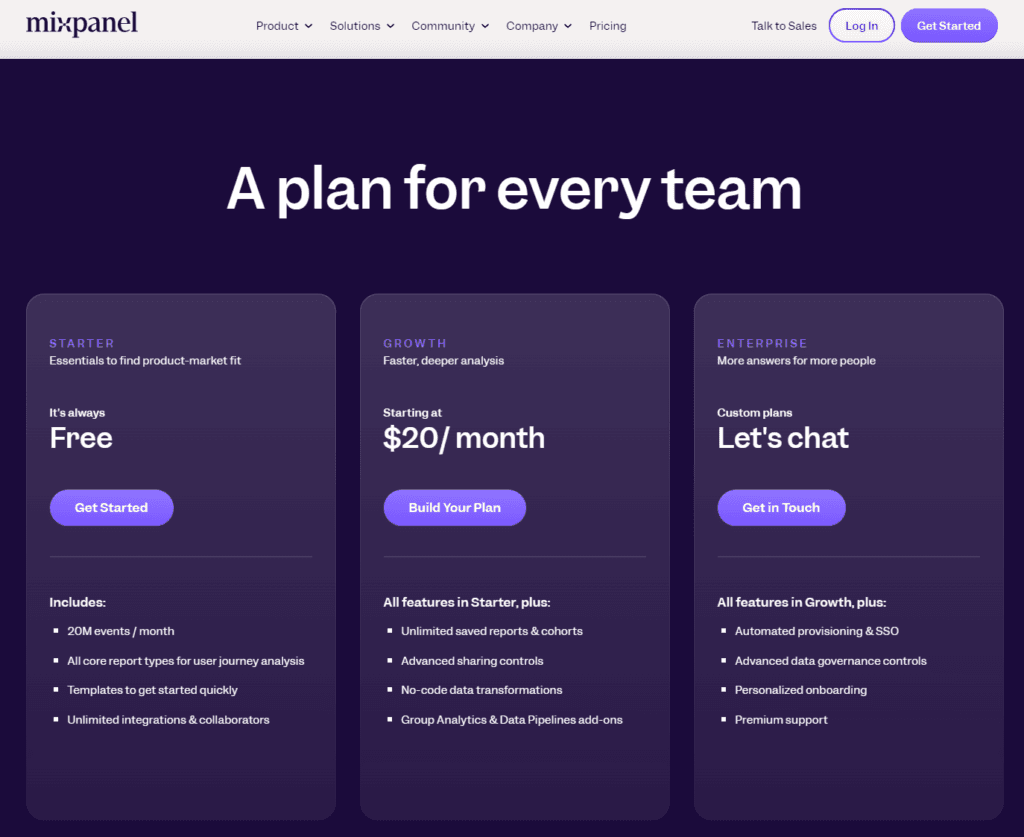In today’s digital age, data is not just a resource; it’s the backbone of informed decision-making. Amidst the vast ocean of analytics tools, QlikView and Mixpanel emerge as two lighthouses, guiding businesses with their illuminating insights. While both shine bright, they illuminate different paths. Let’s embark on a journey to uncover which tool—QlikView or Mixpanel—might be the beacon your business needs to navigate the complex seas of data analytics. Our first port of call? Understanding their approach to data analytics and visualization.
| QlikView | Mixpanel |
|---|---|
 |  |
| G2 Score -4.1 out of 5 | G2 Score -4.6 out of 5 |
| TrustRadius Score -8.0 out of 10 | TrustRadius Score -8.5 out of 10 |
Data Analytics and Visualization: The Heartbeat of Insights
In the quest for data-driven decision-making, the power of analytics and visualization cannot be overstated. They are the heartbeat of insights, pumping life into raw data and transforming it into actionable intelligence. Let’s delve into how QlikView and Mixpanel fare in animating the story your data tells.
QlikView: The Master Sculptor
Imagine data analytics and visualization as sculpture. In this realm, QlikView is the master sculptor, capable of chiseling raw data into the most intricate of statues. With its powerful in-memory processing and comprehensive ETL (Extract, Transform, Load) capabilities, QlikView can handle vast datasets, making it a formidable tool for businesses that deal with complex, multi-source data.
QlikView’s visualization prowess is equally impressive. It provides a wide array of customizable dashboards, charts, and reports, allowing users to tailor their data display to their exact needs. This level of customization enables deep dives into data, offering insights that are not only comprehensive but also highly specific to the business’s unique questions.
However, wielding QlikView’s sculpting tools requires skill and patience. The platform’s rich features and capabilities come with a learning curve, necessitating a certain level of expertise to fully exploit its analytical and visualization potential. For organizations with the resources to climb this curve, QlikView offers unmatched depth and flexibility in data analysis.
Mixpanel: The Agile Painter
On the other side of the canvas, Mixpanel is like an agile painter, swiftly bringing data to life with broad strokes. It specializes in event-based analytics, particularly adept at tracking user interactions across websites and applications. This focus makes Mixpanel a powerful tool for businesses keen on understanding user behavior, engagement, and retention.
Mixpanel’s approach to visualization is centered on clarity and immediacy. Its dashboards and reports, while perhaps not as customizable as QlikView’s, are designed to be intuitive and easy to use. Users can quickly set up and start tracking specific events, creating visualizations that offer immediate insights into how users interact with their digital products.
The beauty of Mixpanel lies in its simplicity and focus. It strips away the complexity of data analysis, making it accessible to users regardless of their technical expertise. For startups and digital-centric businesses looking for quick, actionable insights into user behavior, Mixpanel provides a clear, concise window into their data.
Pricing: Unveiling the Treasure Chest
In the treasure map of analytics tools, pricing structures play a critical role in guiding businesses towards their ideal solution. Both QlikView and Mixpanel offer powerful insights, but their costs can influence whether they’re the right fit for your expedition. Embarking on a data analytics journey with either QlikView or Mixpanel is an investment in your business’s future. Whether you choose the tailored approach of QlikView or the straightforward, scalable model of Mixpanel, ensuring your choice aligns with your budget and analytics ambitions is key to unlocking the treasure trove of insights within your data.
QlikView: Crafting Your Own Treasure Map

QlikView’s pricing model is akin to crafting your own treasure map. It operates on a license-based structure, which can be customized based on the needs and scale of your organization. This includes considerations for the number of users, the server requirements, and access to various features and support services.
This customizable approach means that businesses can tailor their investment to match their specific analytics requirements. However, it also implies that getting a clear picture of the cost requires a consultation with Qlik’s sales team to obtain a customized quote. For organizations with complex data landscapes and a need for deep analytics, QlikView’s model can offer significant value, as it provides a robust, tailored solution.
The investment in QlikView is multifaceted, encompassing not just the financial outlay but also the resources dedicated to mastering its capabilities. It’s suited for businesses prepared to invest in a comprehensive tool that can handle intricate data analysis.
Mixpanel: The Clear-Cut Treasure Chest

Mixpanel offers a more straightforward, subscription-based pricing model. It’s designed to be transparent, with costs clearly outlined based on usage levels, particularly the number of data points tracked. This model allows businesses of all sizes to predict their investment and scale their usage as their data analytics needs grow.
Mixpanel’s pricing is segmented into tiers, starting with a free tier for basic analytics needs and scaling up to more feature-rich plans that cater to businesses requiring advanced analysis and greater data capacities. This clear-cut approach makes Mixpanel an attractive option for startups and digital-first businesses that need immediate insights into user behavior without a significant upfront investment.
The subscription model ensures that businesses can access a powerful analytics platform with predictable costs, making it easier to budget for and integrate into their operations.
User Segmentation and Event Tracking: Navigating User Insights
Understanding your users’ behavior and segmenting them based on their actions and characteristics are like charting the stars to navigate the seas. This knowledge allows businesses to personalize experiences, optimize products, and ultimately, steer towards greater user satisfaction and retention. Let’s see how QlikView and Mixpanel fare in these critical areas.
QlikView: The Deep-Dive Submarine
In the context of user segmentation and event tracking, QlikView is akin to a deep-dive submarine, capable of plunging into the depths of data to uncover detailed insights. With its robust data processing capabilities, QlikView enables businesses to segment users based on a wide range of criteria, pulling from various data sources for a comprehensive view.
However, the strength of QlikView in this area is closely tied to its general approach to data analytics: it requires a significant amount of setup and customization to tailor these segments and track specific events. This means businesses can achieve highly detailed user segmentation and event tracking, but it often necessitates a skilled operator at the helm, familiar with QlikView’s complexities and capable of navigating its depths.
Mixpanel: The Agile Speedboat
Mixpanel, with its focus on event-based analytics, is like an agile speedboat, designed specifically to navigate the waters of user behavior with speed and precision. It allows businesses to easily track user interactions with their digital products in real time, from page views and clicks to more complex actions like sign-ups and purchases.
What sets Mixpanel apart is its ability to not just track these events but to segment users based on their behavior directly within the platform. This capability is built into the core of Mixpanel, making it incredibly straightforward to create dynamic user segments and gain immediate insights into how different groups interact with your product. This focus on agility and specificity makes Mixpanel a powerful tool for businesses that prioritize quick, actionable insights into user behavior.

Related: Check out our free SEO suite

Real-time Analytics: The Lookout at the Crow’s Nest
Real-time analytics is about keeping a vigilant eye from the crow’s nest, scanning the horizon for actionable insights as they unfold. It’s not just about having data; it’s about the immediacy with which it can be harnessed to make decisions that steer the business. Here’s how our contenders fare in providing these timely insights.
QlikView: The Broad View Telescope
QlikView, with its robust in-memory engine, offers a broad view telescope, providing a powerful platform for real-time analytics, albeit with a focus on internal, operational data. It excels in aggregating and processing large volumes of data quickly, offering businesses the ability to glean insights from their operations as events are happening. This capability is crucial for organizations that rely on timely data to make quick decisions, particularly in areas like inventory management, financial reporting, and operational efficiency.
However, the real-time capabilities of QlikView are most effectively unlocked with a deep understanding of its system and a deliberate setup of dashboards and reports designed to refresh at near real-time intervals. This requires not just an investment in the tool but also in the expertise to wield it effectively, ensuring that the telescope is always focused on the most critical data horizons.
Mixpanel: The Agile Spyglass
Mixpanel, on the other hand, offers the agility of a spyglass, specifically designed to provide real-time insights into user behavior on digital platforms. Its strength lies in event-based tracking that updates instantly, allowing businesses to see how users are interacting with their products at any given moment. This immediate feedback loop is invaluable for digital-first businesses that need to iterate quickly, test new features, and respond to user feedback in agile development cycles.
The real-time analytics capabilities of Mixpanel are inherently user-centric, focusing on providing insights that are immediately actionable for improving user experience, engagement, and retention. Its platform is built to offer these insights with minimal setup, making it accessible to teams without deep technical expertise, ensuring that even the most sudden shifts in user behavior can be captured and acted upon swiftly.
Conclusion
The journey doesn’t end with choosing between QlikView and Mixpanel. Whichever tool you select, the true voyage lies in leveraging the insights it provides to steer your business towards success. Whether it’s the customizable depth of QlikView or the focused agility of Mixpanel, the goal is to harness data in a way that illuminates the path to informed decisions and strategic growth.
As we dock at the conclusion of this exploration, remember that the seas of data analytics are ever-expanding, with new tools and technologies constantly emerging on the horizon. Staying informed, adaptable, and curious will ensure that your business not only navigates these waters successfully but thrives in the digital age.
READ NEXT:
- Schema Markup for Educational Websites: A Step-by-step Guide
- MicroStrategy vs Heap: The Best Analytics Tool for You
- Elementor vs Beaver Builder: The Best Landing Page Tool for You
- QlikView vs HubSpot Marketing Analytics: The Best Analytics Tool for You
- QlikView vs MonsterInsights: The Best Analytics Tool for You
- 11 Marketing Analytics Tools to Elevate Your Data-Driven Strategies
- Delivra vs EmailOctopus: The Best Email Marketing Tool for You
- 29+ Digital Analytics Software to Skyrocket Your Digital ROI




















